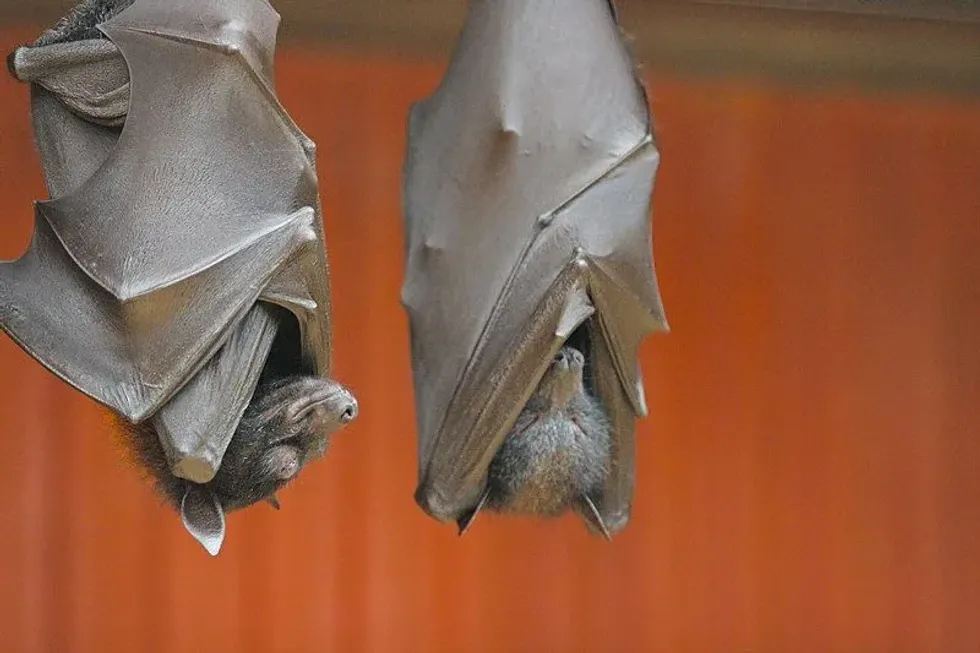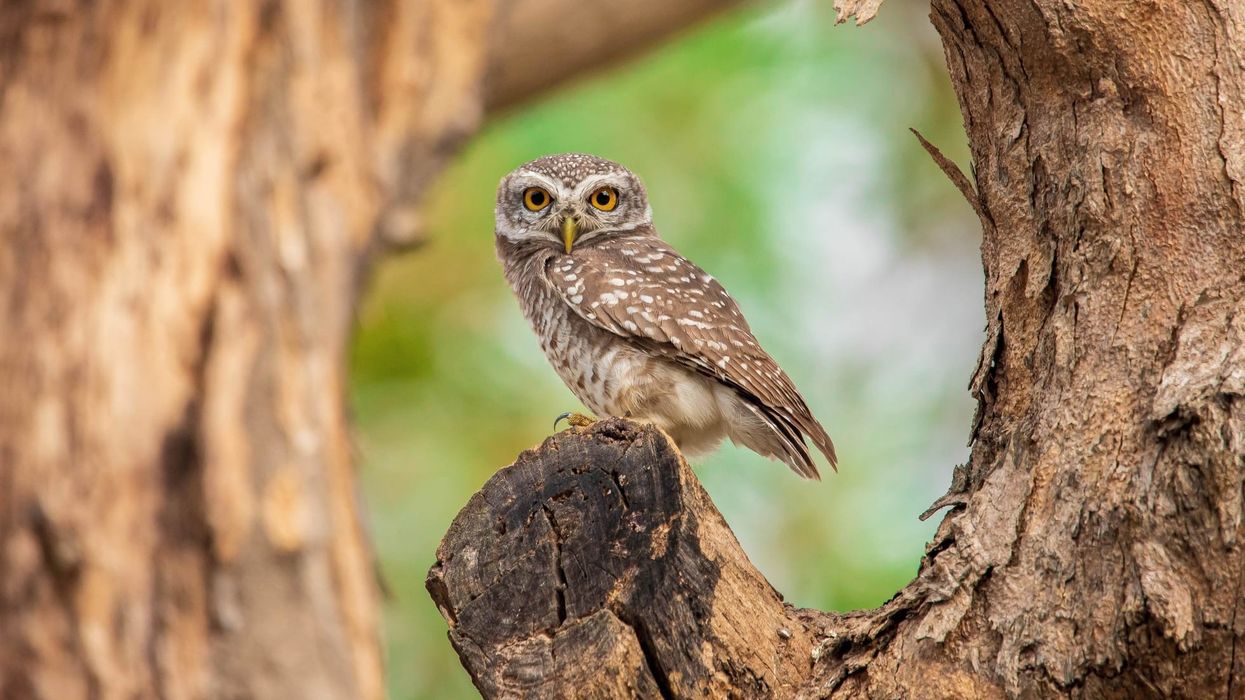One of the largest species of bat, the large flying fox (Pteropus vampyrus), is known by several different names such as the Malaysian flying fox, Malayan flying fox, large fruit bat, greater flying fox, kalang, or kalong. Unlike most species of bats, the large flying fox primarily feeds on fruits, flowers, nectar, and leaves.
The average body length of the species is around 11–13 in (27–32 cm) but the bat weighs between 1.4-2.4 lb (0.6-1.1 kg). As the name suggests, the species has a fox-like face with pointed ears.
The color of the body generally varies, young bats are found in pale gray-brown color, unlike adults while their chest is dark-golden brown or dark russet. These bats possess long and wooly hair on their bodies but the hair on the upper back is shorter.
The species dwell in mangrove forests, tropical forests, and swamps of several countries of Southeast Asia such as the Philippines, Indonesia, and Malaysia. The bats are also spotted in a few regions of Madagascar and Australia.
The International Union of Conservation of Nature has listed the species in the Near Threatened category, the population is declining due to factors like habitat destruction, hunting, and predation.
Let's read more interesting facts about the large flying fox and if you found this article insightful, don't forget to check out exciting information about different animals like Rodrigues flying fox and ghost bat.
Large Flying Fox Interesting Facts
What type of animal is a large flying fox?
The large flying fox (Pteropus vampyrus) is a bat that possesses a fox-like face. The species is known by several names such as the Malaysian flying fox, Malayan flying fox, large fruit bat, greater flying fox. Unlike other old-world fruit bats, the large flying fox lacks the ability to echolocate.
What class of animal does a large flying fox belong to?
The large flying fox belongs to the class of Mammalia, the family of Pteropodidae, and the genus Pteropus, also known as the genus of largest bats. The genus consists of around 60 surviving species of the largest bats in the world.
How many large flying foxes are there in the world?
The exact population of large flying foxes is not known as of now, but studies reveal that the numbers are falling drastically. Also, from 2002-2006, around 22,000 flying fox bats were hunted every year. If 22,000 bats are hunted every year, the bat species would become Extinct in the coming decades.
Where does a large flying fox live?
The large flying fox species is found in several countries of Southeast Asia such as the Philippines, Indonesia, and Malaysia. The species is also spotted in a few regions of southern Myanmar, Thailand, China, Singapore, Madagascar, and Australia.
What is a large flying fox's habitat?
While talking about large flying fox habitat, the Pteropus vampyrus species inhabits the tropical forests and swamps. The species is also found in oceanic islands and agricultural areas, mangrove forests, coconut groves, and mixed fruit orchards.
Who do large flying foxes live with?
Like other species of bats, large flying fox bats are social and prefer to live in large groups. Generally, a group ranges from 2-50 individuals on feeding grounds and sometimes the group consists of more than a thousand individuals.
How long does a large flying fox live?
The average lifespan of a large flying fox is 15 years, but if kept in captivity, the bat can easily live up to 30 years.
How do they reproduce?
The large flying fox (Pteropus vampyrus) bats are polygynous which means males mate with several females during a breeding season. The breeding season generally differs; in Thailand, the breeding peaks around March and April; in the Philippines, mating peaks during April and May; in peninsular Malaysia, it peaks between November and January.
Small harems or groups are formed which consist of around 10 females and a single male, and the dominant male mates with females. Generally, synchronous birthing takes place and females give birth to around one to two offsprings.
After the birth, mothers carry their babies for a few days while the weaning period lasts for around two to three months. The average weight of newborns is around 0.29 lb (133 g). Parental care is only provided by females while males are involved in protecting or defending the harems.
What is their conservation status?
The International Union of Conservation of Nature has listed the species in the Near Threatened category. Also, the Convention on International Trade in Endangered Species of Fauna and Flora (CITES) listed the large flying foxes under Appendix II.
Chronic over-harvesting and loss of habitat have emerged as the major threats to the species. In western Malaysia, the numbers of large flying foxes are so bad that they could disappear within a few years.
In 2003, around 4,500 bats were killed in a single location in the Philippines. Laws for colony management, hunting are being made to protect the species.
Large Flying Fox Fun Facts
What do large flying foxes look like?
As the name suggests, the large flying foxes have fox-like faces with pointed ears. The color of the body generally varies, adult flying foxes possess a light-colored mantle, unlike young bats.
One would find long and wooly hair on the body but the hair on the upper back is shorter. The wingspan of 5 ft (1.5 m) makes flying foxes one of the largest bats. They have the ability to hang upside-down in a tree.
How cute are they?
Unlike most species, large flying foxes are quite fascinating and one would love to know that the scientific name 'vampyrus' has been derived from the Slavic term 'wampir' that means blood-sucking ghost, but these bats love eating fruits and flowers. The species is also known as a fruit bat.
How do they communicate?
Unlike other species of bats, the large flying foxes lack the ability to echolocate but have well-developed eyesight for flights. The bats generally remain silent but become noisy during feeding.
Loud vocalizations are used to locate other members of the colony, while studies reveal that vocalizations are even used to express emotions. These animals also use the sense of smell to find food.
How big is a large flying fox?
While talking about the large flying fox size, the average body length of the (Pteropus vampyrus) species is around 11–13 in (27–32 cm), but the bat weighs between 1.4-2.4 lb (0.6-1.1 kg). The large flying foxes are around three times larger than red bats and vampire bats.
How fast can a large flying fox fly?
The average speed of flying foxes is around 13 mph (21 kph) but to avoid predation, these animals can easily reach the speed of 19 mph (31 kph). Their wings help them to fly with great maneuverability. The bats generally fly up to 31 m (50 km) every night to reach their feeding grounds.
How much does a large flying fox weigh?
The large flying foxes weigh around 1.4-2.4 lb (0.6-1.1 kg).
What are the male and female names of the species?
There are no specific names given to males and females of the (Pteropus vampyrus) species. Males generally have thicker coats compared to females.
What would you call a baby large flying fox?
People generally use terms such as pups to refer to the babies of large fruit bats.
What do they eat?
Unlike other species of bat, the large flying fox bats are herbivores and primarily feed on leaves, nectar, flowers, and fruits. Flying foxes are important dispersers and pollinators of forest trees. The species often get preyed upon by owls and eagles.
Are they dangerous?
These mammals generally do not pose any threats or danger to humans as they prefer not to live around us but males are quite territorial and if someone tries to provoke or entire their territory, they can turn violent and attack humans.
Several fruits bats such as the Indian flying foxes spread diseases such as henipaviruses and flaviviruses which could really be fatal for humans and domestic animals.
It is advised to wash your hands and consult a doctor if these animals bite you.
Would they make a good pet?
It is illegal to keep large flying foxes as pets in several countries as organizations such as the IUCN and CITES have listed the species in the Near Threatened category. These mammals generally belong to the wild and would never survive in man-made habitats.
Keeping them in captivity would make them very aggressive. They have the freedom to move and feed freely and as humans, it is our duty to protect them rather than keeping in aviaries.
Did you know...
Millions of bats die of white-nose syndrome.
Large flying foxes are known as Chihuahuas of the sky.
The giant golden-crowned flying fox, whose scientific name is Acerodon jubatus, is the largest flying fox.
Every species of the genus Pteropus are not able to echolocate.
The only member of the Pteropodoidea superfamily, megabats consists of the world's largest bats. Megabats such as the giant golden-crowned flying fox (Acerodon jubatus) have a wingspan of up to 5.6 ft (1.7 m) long.
What is the difference between a bat and a large flying fox?
The large flying fox is a herbivore and feeds on fruits, nectar, flowers, and leaves, while most of the bats are carnivores that prey on small animals and insects. Also, bats are known for using echolocations while communicating with each other whereas the large flying fox has well-developed eyesight that helps during in-flight navigation.
Why are they called large flying foxes?
The species of large flying fox is one of the largest in the world, the average body length of the bat is around 11–13 in (27–32 cm). The species is quite big than several hawk species such as the sharp-shinned hawk and Eurasian sparrowhawk.
Apart from the body length, the species possess a fox-like face. The species is also known as Malayan flying fox, large fruit bat, and greater flying fox.
Here at Kidadl, we have carefully created lots of interesting family-friendly animal facts for everyone to discover! For more relatable content, check out these hoary bat facts and Mexican free-tailed bat facts pages.
You can even occupy yourself at home by coloring in one of our free printable bat coloring pages.










